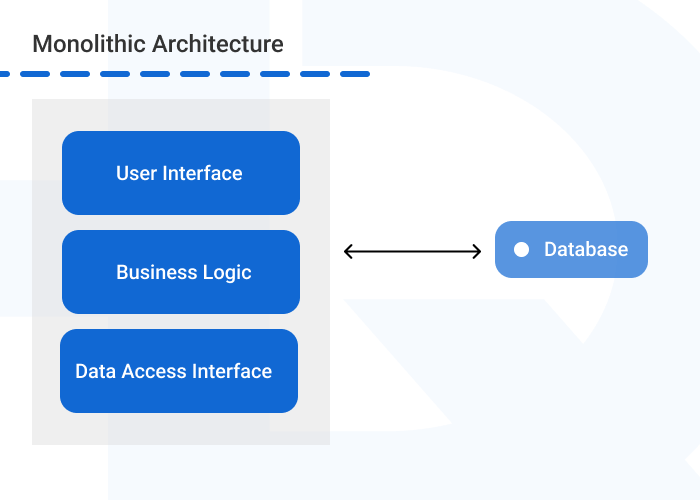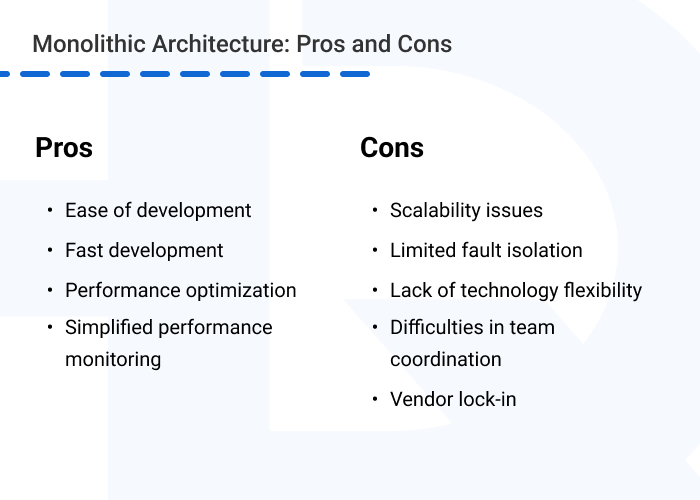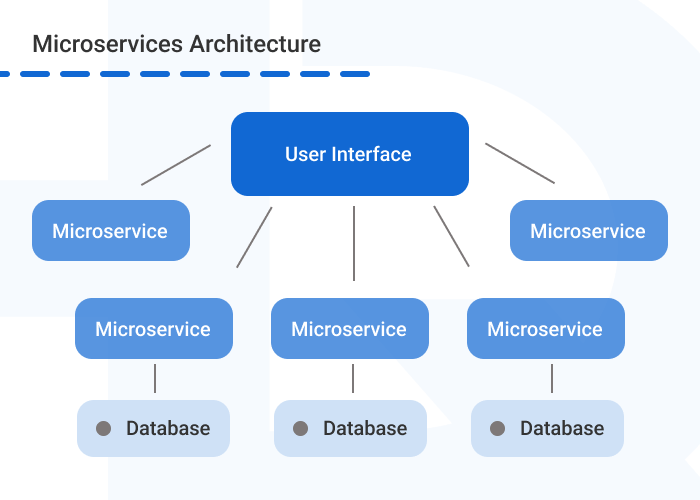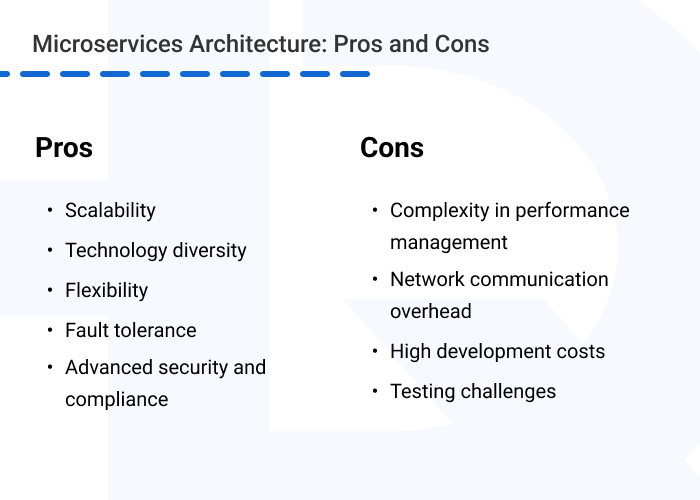What is Monolithic Architecture?
What is Microservice Architecture?
Why Organizations are Switching from Monolithic to Microservices Architecture
In the realm of software development, monolithic architecture features a cohesive structure and unified codebase, while microservices give you more flexibility to scale and innovate. So, the question arises: “Monolithic vs Microservices?”
If you asked this question of HQSoftware’s developers and project managers, who have experience working with both types of architecture, the answer would be: “It depends on your business goals and project requirements.”
There are no tasks that can’t be tackled with a monolithic architecture. But there are many situations where microservices can significantly improve app performance.
Keep reading the article to find out which architecture to choose for your project to remain a winner in the battle of microservices vs monolith.
What is Monolithic Architecture?
What is Microservice Architecture?
Why Organizations are Switching from Monolithic to Microservices Architecture
Monolithic architecture is a software design approach in which an application is designed as a unified, interconnected, and integrated system.
You can visualize a solution built with monolithic architecture as a wall made of bricks. Each brick supports the others, and if you want to change or replace one brick, you may have to rebuild the entire wall.
In the context of monolithic architecture, the bricks symbolize the functional modules of an application, closely interlinked with one another. Therefore, changes or errors in one module can affect the whole system.

All features and functionalities of a monolithic app, including the user interface, business logic, and data access, share the same codebase and data stores and run within a single process. Thus there are both pros and cons of monolithic architecture.
Let’s begin by looking at some advantages to monolithic architecture:
With all these benefits of microservices vs monoliths, you can see that monolithic architecture is ideal for small projects or solutions with basic functionality. The problem arises when it’s time to scale.
The weak points of monolithic architecture are:

Now you see why many companies have been looking for something more advanced that would allow them to scale efficiently while avoiding these limitations. That’s how microservice architecture has come into the picture.
A microservices architecture, or simply microservices, is an approach in which complex applications are broken down into smaller, manageable components, known as microservices.
Each service is responsible for a specific set of features and can be developed and deployed independently. It has its own business logic and codebase and uses APIs to communicate with other microservices.

The ability to manage each microservice independently is the main benefit of microservices vs monolithic architecture. Other advantages include:
However, before being captivated by the pros of microservices architecture, pay attention to some cons as well.
The disadvantages of microservices include:

However, with proper planning and a skilled development team, you can overcome many of these challenges. So, carefully evaluate your business requirements and technical capabilities to decide whether to turn to microservice architecture.
As we mentioned earlier, every project can be built using proven monolithic architecture. But there are some reasons why you may choose to switch from monolithic to microservices:
The first reason to choose microservices is obvious — your business is growing. So is the complexity of your application’s functionality, database demands, and incoming requests.
With microservices, you can allocate resources to the services that need to scale. Also, by scaling the relevant services, you can ensure efficient processing of data without overloading the entire system.
Planning migration to microservices? We’re ready to help!HQSoftware has a team of skilled professionals ready to tackle your request. Let’s talk!
Anna Halias
Business Development Manager
That was the reason one of our clients — a provider of audit services for SMSF funds in Australia — turned to microservices architecture.
Smooth data handling is a crucial requirement for fintech solutions, especially when the database is growing. By implementing microservices, our team was able to migrate the solution from legacy to modern technologies and establish reliable performance with an extensive volume of financial documents. As a result, the customer increased the number of users and was able to sell the solution to other companies, thus opening a new revenue channel.
If your solution covers a wide range of business aspects, delivering rich functionality, microservices can be a beneficial choice for you.
Igor Kunovskiy
Lead Software Engineer
at HQSoftwareA complex system responsible for various business areas can definitely benefit from microservices. A part of the business, even during development, may require faster updates, support, or functionality development than other parts. Microservices ensure that these innovations are implemented quickly without destroying already existing modules.
With microservices, you can achieve stability in your solution thanks to:
With microservices, you’re not limited to a unified monolithic stack and can use the best technologies and frameworks for specific functionalities. This agility lets you stay at the forefront of innovation, providing enhanced features and smooth experiences to users.
That’s why we implemented a microservice architecture for our client’s real-time traffic safety system. The solution had performance issues and couldn’t handle the volume of required requests. This was mainly because it was built on outdated technologies.
To update the system and streamline its operations, our team decided to implement microservices. This enabled us to select the most suitable technology stack for each functional module and facilitated the development and maintenance processes. The upgraded solution gained a significant increase in performance, smoothly handling an increasing number of users.
Imagine that your app has specific functionality that needs to be updated, for example, once a week or two, while other features remain stable.
With a monolithic architecture, updates of one feature can affect or even destroy the whole application, requiring considerable resources for implementation. With microservices, you can change only one module without interrupting others.
Igor Kunovskiy
Lead Software Engineer
at HQSoftwareOne more advantage is that with microservices you can ensure backward compatibility with previous versions of the app, to prevent conflicts for users who might not immediately update.
Switching to a cloud environment and adopting microservices architecture makes for a powerful combination. It enables you to build scalable and flexible applications while leveraging cloud benefits such as cost-effectiveness and ease of deployment.
An illustration of this synergy can be found in HQSoftware’s experience. By transitioning to microservices and leveraging cloud technology, we developed a robust e-learning and performance-tracking system. The outcome? Enhanced performance, expanded capabilities, and over 50,000 users across various industries.
As you see, there are many reasons to choose microservices over monolithic architecture. Both options have their pros and cons, so it’s your decision.
However, if you struggle to understand technical details or can’t evaluate your technical capabilities to select monolithic vs microservices, feel free to contact us! Relying on our extensive experience in app redesign and development, we will help you choose the best architecture according to your unique business needs.

Head of Production
To ensure the outstanding quality of HQSoftware’s solutions and services, I took the position of Head of Production and manager of the Quality Assurance department. Turn to me with any questions regarding our tech expertise.
We are open to seeing your business needs and determining the best solution. Complete this form, and receive a free personalized proposal from your dedicated manager.

Sergei Vardomatski
Founder